Mexico › Mazatlán
Updated: March 1, 2022
See Also
Mazatlán is one of Mexico’s most atmospheric resorts, a laid-back, historic city on the western, Pacific coast, and one of our favorite places to go for good seafood, sun and sand.
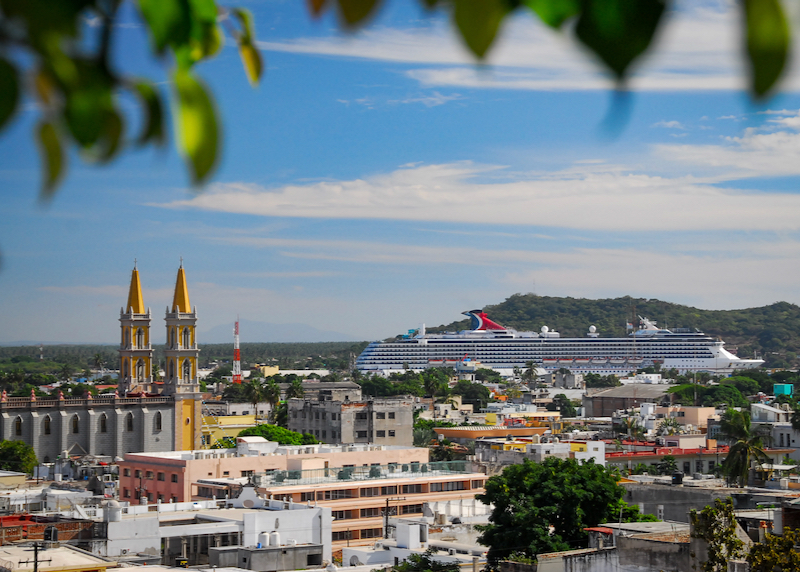
Downtown old Mazatlan with the cathedral and a cruise ship in the distance.
Frequently Asked Questions about Mazatlán
Where is Mazatlán?
Mazatlán is a city in Mexico, on the western, Pacific coast of the country in the state of Sinaloa. Mazatlán lies about 1030 km northwest of Mexico City, 220 km south of state capital Culiacán, and 440 km north of Puerto Vallarta. Non-stop flights to Mazatlán take 2 hours 40 minutes from Los Angeles, 2 hours 15 minutes from Tijuana, 1 hour 40 minutes from Mexico City and 1 hour 25 minutes from Monterrey.
How big is Mazatlán?
Mazatlán has a greater metro population of almost 490,000. The main city and busiest resort area stretches some 30km north to south along the Pacific coast. Pristine beaches and smaller resorts fan out either side of the central “Zona Dorada” (“Golden Zone”), the traditional hub for accommodation and tourist activities.
What is the history of Mazatlán?
Mazatlán claims an official foundation date of 1531, when the Spanish took control of the area, but nothing much happened here well into the 19th century. Initially little more than a base for smugglers and pirates, Mazatlán gained respectability when a Mexican customs office opened in 1828, and the city finally boomed as a mining port – author Herman Melville visited Mazatlán as a sailor in 1844. In the late 19th century, the city also attracted manufacturing and a large immigrant population – Germans opened the famous Cerveceria del Pacífico brewery in 1900. It wasn’t until the end of World War II that Mazatlán started to attract tourists, initially American sport fishermen (today it still operates the largest canneries and shrimp fisheries in the country). Writer Jack Kerouac passed through in 1952, writing about his visit in Lonesome Traveler. Mass tourism really took off in the 1970s with the development of the “Zona Dorada”, and in the last decade or so the city’s old town or “centro histórico” has been given an attractive facelift.
How do I get to Mazatlán?
Mazatlán is connected to the US and Canada by numerous non-stop flights, though many of these area seasonal; most flights will otherwise route through Los Angeles or Dallas/Fort Worth. Non-stop domestic flights link Mazatlán with Monterrey, Tijuana, Mexico City, and several smaller cities. There are no direct flights from Europe – most visitors travel through the US or Mexico City.
Within Mexico, first-class long-distance buses are an economical and comfortable alternative to flying – buses to Guadalajara (6–7 hours), Mexico City (14–15 hours), and Puerto Vallarta (7 hours 30 minutes) operate frequently (24 hours).
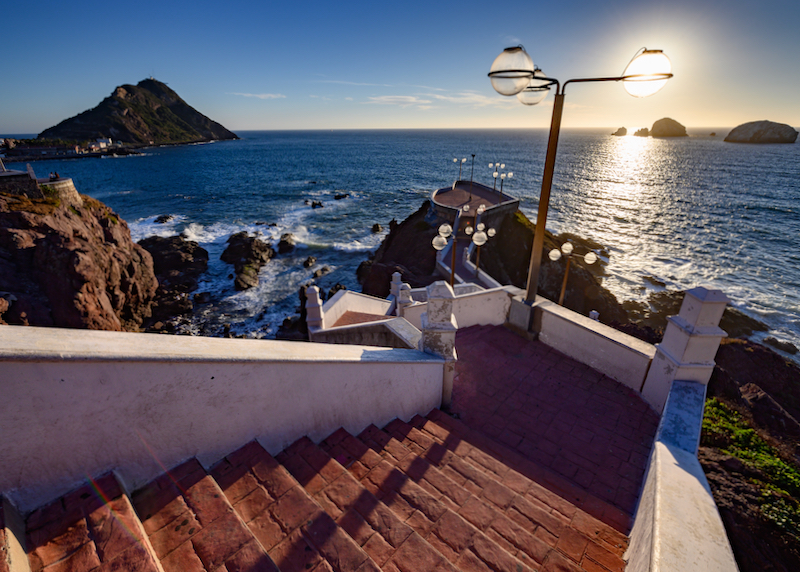
Stairs down to a lookout point along the waterfront.
What are the options for airport transportation in Mazatlán?
Mazatlán’s International Airport lies some 20km south of the city center. Arrival can be quite chaotic – ignore the timeshare sales staff upon exiting and their offers of rides into the city. Look instead for the official “Taxi” desk and pay for transportation there – or arrange rides in advance with companies like Mazatlan Tours.
The cheapest transportation is provided by vans (or “colectivos”) that offer fixed rates to the old town and Zona Dorada – usually 125 pesos. This is a great deal, but note that if the van is full and your hotel happens to be the last stop, the trip can take well over 2 hours (it only takes 30 minutes by taxi).
Like most airports in Mexico, private taxis operate a monopoly here and rates are relatively expensive, ranging from US$25–60, depending on where the hotel is. The price will be fixed in advance at the Taxi Desk at the airport – there are no meters inside the taxis. The desk will accept US or Canadian dollars in addition to Mexican pesos, but payment is cash only. All the major car rental companies have desks at the airport.
Can I use Uber in Mazatlán?
Uber is available in Mazatlán (assuming phones have roaming, and the app works), and can offer convenience and much cheaper rates over traditional taxis. Most short trips in town range 30 to 45 pesos, with journeys between the Old Town and Zona Dorada around 65 pesos, and rides out to Cerritos around 100 pesos.
However, Uber drivers are legally forbidden to provide airport pick-ups. The local airport taxi drivers (as is typical in Mexico) are very territorial – even though Uber drivers are allowed to drop-off at the airport, most drivers will refuse for fear of reprisals. Within the city, taking Uber is usually fine.
Various other ride-sharing apps operate in Mazatlán, with Chinese-owned DiDi offering slightly cheaper rates, and Estonia-based Bolt another alternative, but we’d recommend sticking with Uber for first-time visitors.
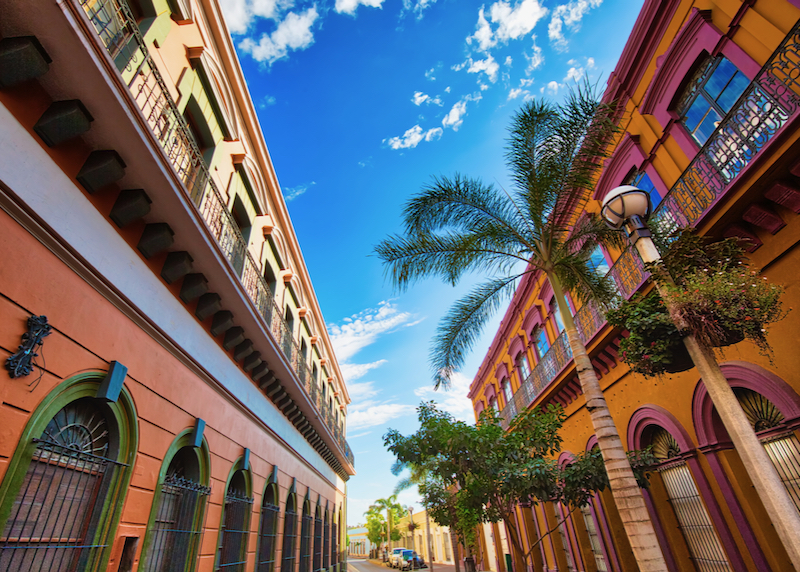
Colorful old city streets in the historic city center.
Can I drive to Mazatlán?
We would urge caution in driving to Mazatlán. Driving down from the US border is relatively straightforward – the main highways are in good condition all the way. However, beyond the tourist centers, the states of Sinaloa and Sonora have a reputation for drug violence that makes driving some areas a potentially dangerous proposition – driving at night should be absolutely avoided. The drive from Mazatlán to Nogales on the border with Arizona on Hwy-15 is around 1170 km (727 miles) and 14 hours non-stop. Foreign vehicles also require a Mexican “Temporary Importation of Vehicle Permit”, arranged at the border or before departing.
Do I need a car in Mazatlán?
Public transport is incredibly prolific and cheap in Mazatlán making a car unnecessary (see below).
The Old Town is best explored on foot, and it’s easy to reach all the main beaches by bus or taxi.
How do I get around Mazatlán without a vehicle?
There are so many options to getting around Mazatlán without a car! Public transport is fun and cheap in Mazatlán. First-time visitors should try the pulmonías (a bit like souped-up golf carts but usually modified VW Beetles, blaring Mexican music). Fares depend somewhat on negotiation skills – rides between the Zona Dorada and Old Town usually cost around 150 pesos. Larger red pick-up trucks known as aurigas tend to be cheaper than this, and ideal for big groups – they take 8–10 people at a time – but again, negotiate the rate in advance.
Regular taxis (usually red or green) do not have meters but operate on a (very) rough fixed-rate system, though always confirm the price before getting in. Most short trips in town range 40 to 50 pesos, with journeys between the Old Town and Zona Dorada around 70–80 pesos (and 20 percent more at night). Uber tends to be a bit cheaper (see above).
City buses are a convenient and cheap alternative: the bus identified as “Sabalo-Centro” runs back and forth from the Marina in the north all the way down the seafront through the Zona Dorada and into the Old Town. The bus is air-conditioned and costs just 11 pesos.
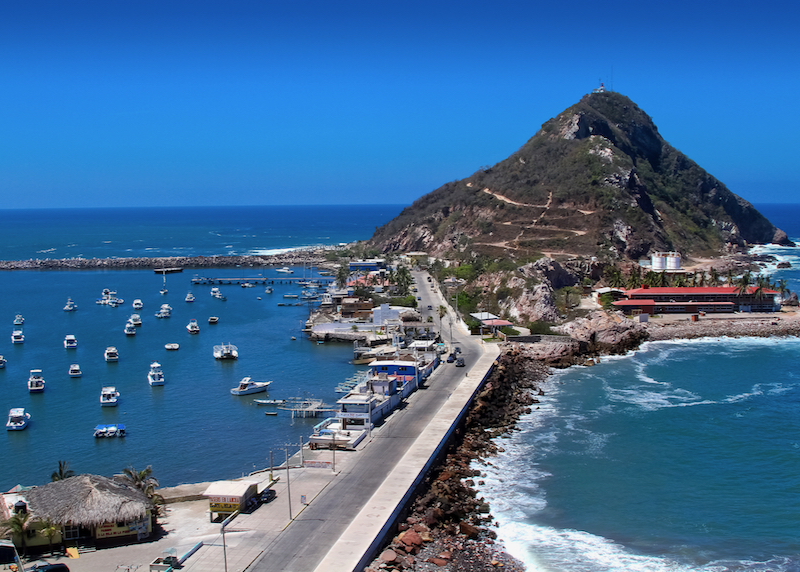
Sailboats and yachts in a marina along the waterfront.
When is the best time to go to Mazatlán?
Mazatlán is at its best between November and May when it’s sunny and very dry. In the summer (July to September) it can be very humid and very hot – it can also rain a lot, though the water is at its warmest for swimming and snorkeling at this time. October and November is a great time to visit – the rainy season is over, but the busy winter season has yet to pick up, so hotels tend to be cheaper.
Where should I stay in Mazatlán?
Most tourists in Mazatlán stay in the Zona Dorada, the “Golden Zone” fronting the main beaches – this is where the big resort hotels are, as well as a range of budget options. Alternatively, the restored Old Town (or centro histórico) has a lot more character – staying here, in boutique hotels or Airbnb apartments, means a longer journey to the beach but access to a lot more of Mazatlán’s cultural offerings – live music, theater, museums, bars, restaurants, and local markets. Larger and more isolated resorts lie to the north along Playa Cerritos and Playa Brujas in what is known as “Nuevo Mazatlán”.
What are the best beaches in Mazatlán?
Our favorite beaches in Mazatlán include the small beach on the Isla de la Venados (Deer Island), 2 km off the coast – all the tour operators in the Zona Dorada offer boat trips – and the Isla de la Piedra (actually a long peninsula), which boasts a long, sandy beach ideal for swimming, with several no-frills Mexican beach bars and restaurants. To get there, take a bus or taxi to the “Embarcadero” at the southern end of the Old Town, then catch a motorboat across the channel.
The primary tourist beaches that line the Zona Dorada – known as Playa Gaviotas and Playa Sábalo further north – are perfectly fine, often busy but clean and convenient for hotels and amenities. Further north the beaches are wilder and emptier; aim for Playa Cerritos or Playa Bruja (both accessible by bus) for a quieter experience.
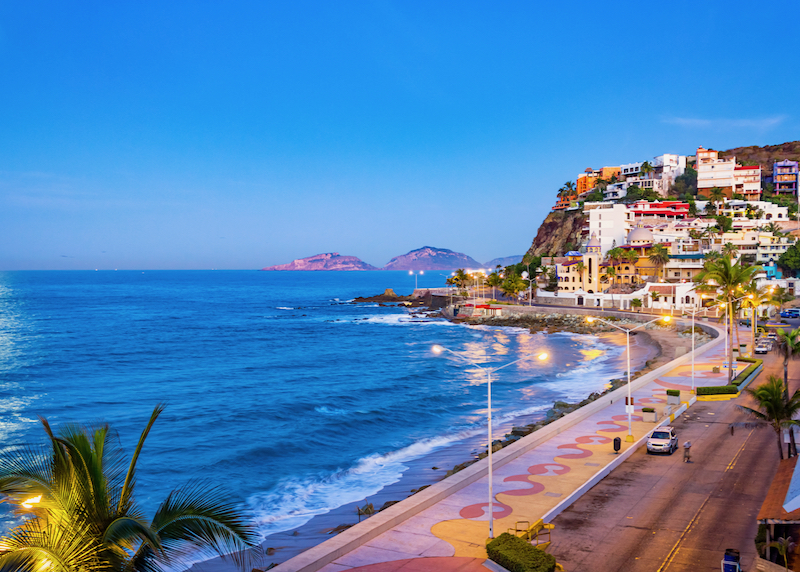
Waterfront promenade just after sunset.
Where to change money in Mazatlán?
The Mexican peso is the official currency in Mazatlán (often prefixed with a “$” sign), and though some hotels, restaurants, and vendors may accept US or Canadian dollars, most local businesses only deal in pesos. Try to use ATMs to withdraw peso cash in Mazatlán if possible (check with the bank before leaving to confirm it’s possible to use a debit card and how much they will charge – using credit cards can incur interest and foreign transaction fees). Credit cards are widely accepted, but cash is needed for buses, most taxis, and small purchases.
What are the best things to do in Mazatlán?
The best things to do in Mazatlán are connected with the beaches; swimming, surfing, sunbathing, and various watersports. Other pleasures include dining, drinking, and shopping, particularly in the resurgent Old Town. It’s worth strolling the historic streets around the Plaza Machado, taking in the 19th-century Teatro Ángela Peralta, the small but absorbing Museo Arqueológico (archeological museum), and Museo de Arte (art museum), with its displays of modern Mexican paintings and sculpture. The colorful stalls of the grand old city market, Mercado Pino Suárez, are also worth perusing.
Other highlights include viewing the world’s largest mosaic mural at the Mazatlán International Center; hiking up to the lighthouse (“El Faro de Crestón”) at the far southern edge of the city; enjoying a cocktail at historic Bar Belmar, overlooking Playa Olas Altas; and watching the cliff divers at “the Mirador”, on the seafront. For a bit more excitement tackle the multiple ziplines at Huana Coa Canopy Adventure, just outside the city (tours that include transport are sold all over town and in hotels). Mazatlán is also a great place to learn to surf – contact Jah Surf School.
What are the restaurants in Mazatlán like?
The restaurants in Mazatlán are pretty good, a mix of classic Mexican and international. In the Old Town, Casa Etnika sells handicrafts as well as Oaxacan coffee and snacks, while Topolo and El Aljibe de San Pedro are our go-to’s for high-quality Mexican cuisine. Asian-fusion specialist Water’s Edge Bistro is our overall favorite restaurant for a big night out. In the Zona Dorada we recommend Casa Loma for a romantic dinner, and Twisted Mama’s for international dishes, cocktails and nightlife.
Is Mazatlán expensive?
Everything is relative of course, but Mazatlán is one of Mexico’s more affordable resorts. Hotels tend to be reasonably priced, public transport is very cheap, and meals and activities won’t cost much – almost everything is priced in pesos, not US dollars.
Is Mazatlán safe?
Yes. Despite the state of Sinaloa being one of Mexico’s drug cartel hotspots, Mazatlán itself is safe for tourists to visit. The Zona Dorada, Old Town, and Malecón (seafront) are well-policed, even at night. We would advise not to travel outside the city alone (organized tours are OK), and to take the usual precautions.
Read More
- Cancun – Best Hotels
- Cancun – Family Hotels
- Isla Mujeres – Best Hotels
- Isla Mujeres – Family Hotels
- Los Cabos – Travel Guide
- Los Cabos – Best Hotels
- Los Cabos – Family Hotels
- Mazatlan – Best Hotels
- Mazatlan – Family Hotels
- Playa del Carmen – Best Hotels
- Playa del Carmen – Family Hotels
- Puerto Vallarta – Best Hotels
- Puerto Vallarta – Family Hotels
- Punta de Mita – Best Hotels
- Sayulita – Best Hotels
- Tulum – Best Hotels
- Tulum – Family Hotels